#Genus: Coccinella
Text
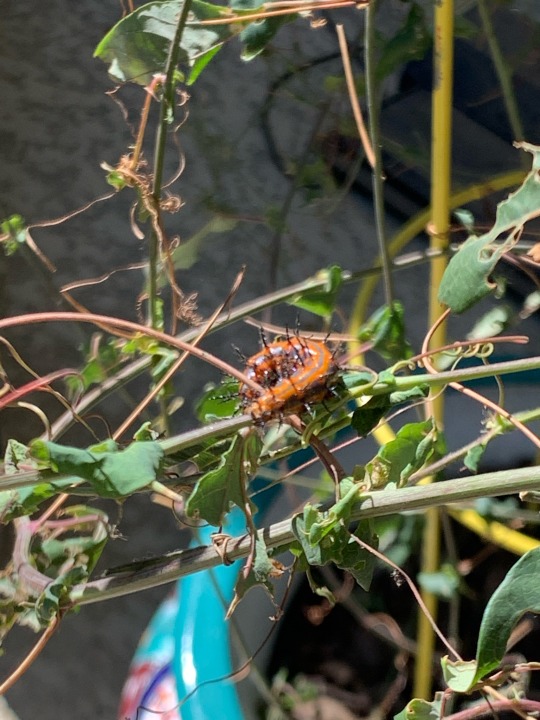


An Asian Lady Beetle and Gulf Fritillary larvae!
#Phylum: Arthropoda#Class: Insecta#Order: Coleoptera#Order: Lepidoptera#Family: Coccinellidae#Family: Nymphalidae#Genus: Coccinella#Genus: Dione#Coccinella septempunctata#Dione vanillae#Seven-Spotted Lady Beetles#Gulf Fritillaries#Brush-footed butterflies#Lady Beetles#butterflies#beetles#insects#arthropods
3 notes
·
View notes
Text
Orbeetle Facts
(I have one named Joker and the entire time I was writing this, he was floating around and trying to type on it. I just felt the need to share this)
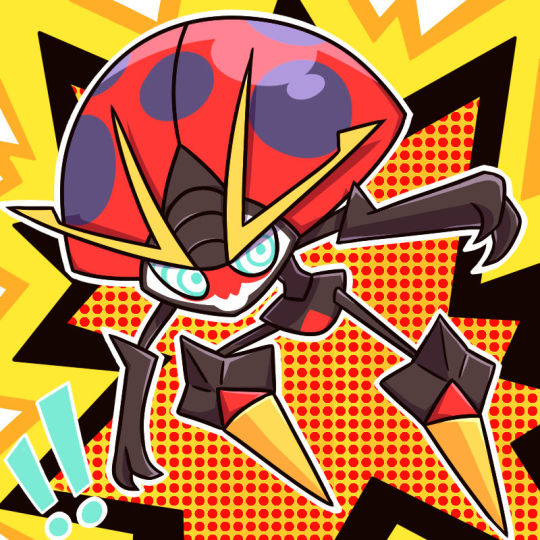
(Art by isoptin on Deviantart)
-The genus name for the Orbeetle line is "Coccinella Praedica" which roughly translates to "Scarlet Prediction"
-Because of their appearance, with their eyes being all swirls, their antenna looking like angry eyebrows, markings resembling a mustache, etc, they're often Pokemon chosen to be the smart villains in a lot of comics and movies
-Unlike most other flying (not flying type; just bugs thst fly) Bug Pokemon, Orbeetle's elytra don't protect any wings. They instead use it to protect their brain. The elytra evolved to be small buds from lack of use
-Orbeetle are related to the Ledyba line, with both of them having a common ancestor
-Orbeetle's name comes from Orb and Beetle, which would make Orbeetle sound like orbital, referencing the way it moves around (similar to a satellite)
-Because of their gigantimax form, there are theories saying that Orbeetle came from space. These theories are not true, and I can not express enough how misinformed this theory is
-Orbeetle have a very violent mating ritual. I won't go into detail, but it involves biting, scratching, stabbing, dragging, etc. They also have a very violent way of protecting their eggs, and I'll link the post talking about it at the end
-Orbeetle have been known to have hypnotize other pokemon and make them their 'minions' that would do anything they ask of them
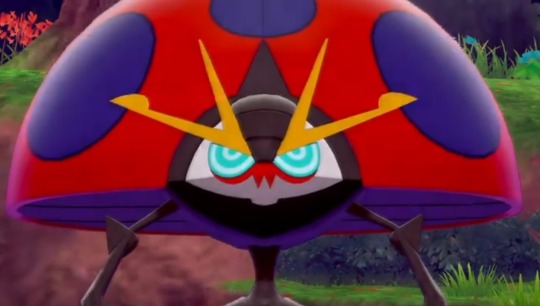
-Because of their intense psychic abilities, Orbeetle are able to sense things with their antenna 15x more likely than the average bug pokemon
-Due to their intelligence, it is actually possible to teach an orbeetle how to read and solve math problems! There was an instance in 2015 Galar where an Orbeetle learned how to solve long division
-Orbeetle are known to be very violent Pokemon in general. We can easily understand where this came from; they're often bullied, picked on, and hunted by larger Pokemon, and the only thing they have going for them is their wits. But when they evolve, they have both the strength and intelligence to get revenge. They end up being really violent and vengeful as Orbeetle
-Going from the fact above, it can be very hard to befriend an Orbeetle if they weren't caught as a Blipbug or Dottler. In the wild, you'll often see Orbeetle have Pokemon close to them that were with them when they were still a Blipbug
-Because of their absolutely massive brain, they aren't able to stand up without using their psychic powers
-Orbeetle are violent hunters, and mostly ear smaller and weaker bug types (never Blipbug though. They tend to leave them alone). But there were some cases where they have taken down Scolipede
-Despite not being from space, Orbeetle actually do surprisingly well there

(Art by artsy-rc on Danbooru)
-There eyes have a hypnotic effect on them, which will swirl when hypnotizing someone
-Female Orbeetle have larger abdomens than male Orbeetle
-In the rare instances when Ledian and Orbeetle interacted, Orbeetle were shown to be passive and even quite friendly with them. This was a large shock to researchers, since Orbeetle would usually attack bug pokemon similar to Ledian. The most popular theory they have is that Orbeetle might see themselves in Ledian, with both of them being Coccinellidae pokemon
-In many spiritualities, the number 7 symbolizes intellect, wise, insight, truthfulness, and intuition. I theorize that this came from Orbeetle
-While Blipbug are seen as pests by a lot of farmers, Orbeetle are seen as a good thing for farmers since they eat the Pokemon that would eat their crops
-Orbeetle are not very affectionate with their trainers, but they'll often give gifts to them to show they care

(Art by Inesanemona on zerochan)
Joker is still hovering, so I decided to let him type something:
"Helo ddhduishejslauwbebfjdbsjsndx"
-Joker (I taught him how to spell "Hello." Be nice. He is still learning)
Anyways, here's the other Orbeetle post
#ooc: made ledian and orbeetle get along because its an alien and ufo#ooc: and there also doesnt always need to be a reason we csn wxplain yet#ooc: like how alligators will judt leave manatees alone and scientists still dont know why#orbeetle#blipbug#dottler#pokemon#pokemon irl#irl pokemon#pkmn irl#irl pkmn#pokeblog#pokeblogging#pokeblr#rotomblr#rotumblr#pokemon roleplay#bug types#psychic types
36 notes
·
View notes
Photo
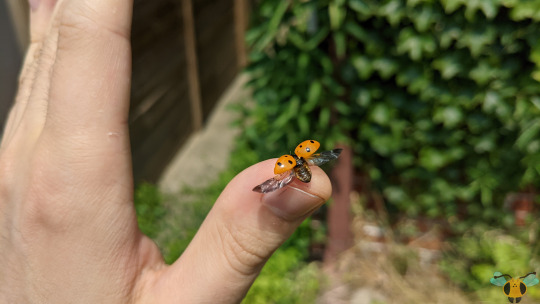

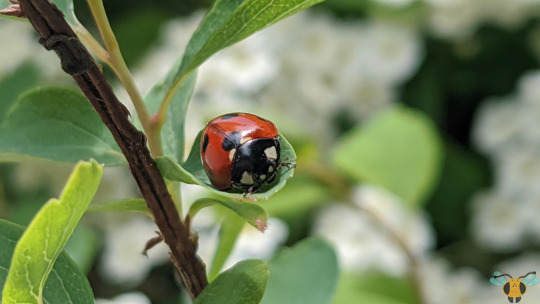
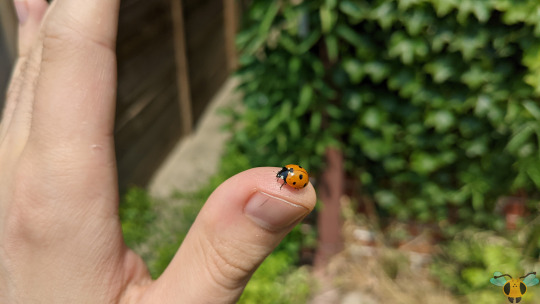






Seven-Spotted Ladybug - Coccinella septempunctata
Let’s give these little spotted gems some love and appreciation. I’ve been a little busy with their smaller and more unknown relatives, but now it’s their turn for the spotlight. There’s been quite a few Seven-Spotted Ladybugs throughout the years, so I’ve found them on many a plant. Large-sized as far as Ladybugs go, they’re easy to spot walking on plants or flying through the air. Don’t swoop down on them if you plan to pick them up; you can coax them onto your hand if you place your fingers nearby or if they land on your clothing. Similar to the Asian Ladybug (or Ladybugs in general for the matter), if frightened or agitated they will emit their smelly and noxious-tasting hemolymph defense to try and escape. Also like Asian Ladybugs, looks like that Seven-Spotted Ladybugs appear red or orange! Keep your palm open and don’t let them feel trapped and the worst they’ll do is draw their legs under their shell to protect them. In my experience they’ll roam on your hand for sometime before eventually flying away or suddenly dropping into the grass below. It’s just what they do to escape the occasional spell of danger since they’re used to feasting on soft-bodied insects with little difficulty...unless Ants are on patrol of course.
I’ve mentioned in posts with other insects that Ants like to tend to honeydew producing insects, offering protection in exchange for that delicious liquid. Now, if honeydew is so tantalizing, couldn’t Ladybug larvae or adults just eat the honeydew? To answer, kind of. The larvae need protein and carbohydrates to grow and molt to their adult forms. so soft-bodied insects are the priority (unless it’s Ladybug that only eats plants such as those of the Epilachna genus). Plus, they get honeydew when they eat the insects anyway. It’s a win-win! Since the adult Beetles can unfold their wings and fly around, they can be more open to other food sources such as honeydew, fruits, pollen and even fungi, depending on the specie. Soft-bodied insects are still best, but there are nutrients from the aforementioned sources that are also beneficial to a Ladybug’s overall health. Looking into it further, nutritional content of soft-bodied insects may vary due to which plant(s) they feed on. These extra food sources have also shown to be especially valued when prey items become more scarce. If only I’d thought to pay closer attention to the individual photographed in September. These diligent creatures need to do everything they can to stay healthy if it means surviving an overwinter or migrating.
Pictures were taken on June 2 and 27; July 12; September 21, 2020 and June 13, 2021 with a Google Pixel 4.
#jonny’s insect catalogue#ontario insect#beetle#seven spotted ladybug#ladybug#coleoptera#insect#toronto#june2020#july2020#september2020#2020#june2021#2021#entomology#nature#ladybird beetle#invertebrates#arthropods
34 notes
·
View notes
Text

°*•🎮» Names !
-> Aero ; a Pantone shade of blue
-> Attacus ; saturnid moth Genus
-> Cinell ; part of the Ladybug genus “Coccinella”
-> Acheron ; A river in the underworld, also means “River of Sorrow”
-> Nirav ; meaning “Silent”
°*•🎀» Pronouns !
-> Az / Azure / Azures / Azureself
-> bug / bugs / bugself
-> stry / Stryd / Stryds / Strydself ; said like “Strid” which is a part of the word “stridulation”, a thing that bugs can do to make noise
-> hex / hexs / hexself
-> ve / ver / Vers / verself ; I’ll be honest I just thought this would match the vibe Sig gives off
#caughtintheweb ; requests !#Sig#Sigkin#otherkin#fictionkin#name and pronoun request#finished request#alterhuman#sig puyo puyo#name request#pronoun request
1 note
·
View note
Text
Simbolo della coccinella

From this flickers an adult who will have an average life between 4 and 6 weeks. The biological cycle begins with the deposition of yellowish eggs by females (about 2,000).įrom these emerges a larva that develops in this stage for about 3 weeks after which it turns into a pupa, a stadium that lasts about a week. An additional defense system consists in the total retraction of the legs under the body to make it more difficult for any predators to catch it. This insect uses stinking excretions produced by the legs and a very colorful livery in order to keep predators away. The common ladybug is a beetle with diurnal habits and the adult appears with the arrival of heat. It has relatively short and rather distant antennas. The garment has powerful jaws and is black. The legs are short both in larvae and in adults and can be completely retracted inside the body. The elytra are bright red, with the presence of three black points for each elitra, and one on the commissure, for a total of seven points (hence the epithet septempunctata). The copro of the Coccinella septempunctata is characterized by a strongly convex, ovoidal shape, with a vividly colored livery. It lives both in natural and agrarian ecosystems but in the latter it is strongly influenced by agricultural techniques with use of insecticides and herbicides. The Coccinella septempunctata is an insect that lives and reproduces in every part of the world especially wherever there are aphids, which are insects that are included in their diet. The common ladybird (Coccinella septempunctata L., 1758) is an insect belonging to the Coccinellidae family.įrom a systematic point of view it belongs to the Eukaryota Domain, Kingdom Animalia, Eumetazoa Subarray, Bilateral Branch, Phylum Arthropoda, Subphylum Tracheata, Superclass Hexapoda, Class Insecta, Subclass Pterygota, Coop Endopterygota, Superorder Oligoneoptera, Section Coleopteroidea, Order Coleoptera, Suborder Polyphaga, Infraorder Cucujiformia, Superfamily Cucujoidea, Coccinellidae Family, Subfamily Coccinellinae, Coccinellini Tribe and therefore to the genus Coccinella and to the C.

0 notes
Note
Do you like ladybugs?
Yes! Coccinellidae are smurfy. I actually have one myself- my familiar, named Snappy Bug. I can't tell which species of ladybird beetle she belongs to- at first glance she appears to be a seven-spotted ladybird, but she only has five spots on her elytra- however, her coloring, anatomy, and diet do seem to smurfpoint her as a member of the Coccinella genus.
#brainy smurf#ask blog#chrono tag#snappy bug#pov ur me whos very american trying so hard to force myself to use the term ladybird
4 notes
·
View notes
Text




Could I have some help identifying this handsome and polite man?
Hello! This little friend is the larval form of Harmonia axyridis, or Asian ladybird/beetle/bug, which has been introduced pretty much worldwide. It has lots of colloquial names and lots of different color patterns as an adult! Here’s a good sampling:

Photo via ©entomart
These are not to be confused with the Coccinella genus, known as ladybugs in the US or ladybirds in Europe. Here’s probably the most famous one, Coccinella septempunctata:

Photo via Dominik Stodulski
Thanks for sharing! As always, submissions don’t count towards the one (1) nice bug per day.
212 notes
·
View notes
Text

Seen: June 2019, Ely MN
The Three Banded Ladybug (Coccinella trifasciata) is native to the United States. Coccinella is the most familiar genus of ladybug. Its name comes from Latin coccineus, meaning scarlet. These beetles eat lots of aphids but can also feed on pollen and nectar.
The females lay yellow-orange oval shaped eggs in clusters on leaves or stems. Eggs hatch into alligator-shaped larvae and undergo four larval instars before pupating and emerging as an adult.
Sources: https://www.inaturalist.org/taxa/51703-Coccinella
https://wiki.bugwood.org/Coccinella_trifasciata#Description
0 notes
Text
Ladybug (Coccinellidae) and Ladybird (Coccinella septempunctata) Insect Animal
Ladybug (Coccinellidae) and Ladybird (Coccinella septempunctata) Insect Animal Ladybug Scientific Name: Coccinellidae Ladybug Kingdom: Animalia Ladybug Phylum: Arthropoda Ladybug Class: Insecta Ladybug Order: Coleoptera Ladybug Suborder: Polyphaga Ladybug Superfamily: Cucujoidea Ladybug Family: Coccinellidae Ladybird Scientific Name: Coccinella septempunctata Ladybird Kingdom: Animalia Ladybird Phylum: Arthropoda Ladybird Class: Insecta Ladybird Order: Coleoptera Ladybird Family: Coccinellidae Ladybird Genus: Coccinella Ladybird Species: C. septempunctata #ladybug #ladybird #insect
Watch video on YouTube: https://youtu.be/wcIFb42ddRM
0 notes
Photo










Personal (Short) Project, Ladybirds (pt1) Secondary Research of Colours and Species
Upon establishing the project I began researching into the various types of species of Ladybird, to first begin understanding them (their role in nature, their food their habitats) and where I could find links to a more Gothic nature for design purposes, secondly to comprehend the various types of Ladybird and thirdly to record their colour and interpret them as need be in relation to the overarching project.
Here (above) and in the mood board link below you can see my visual research as an attempt to comprehend the variety of colours Ladybirds appear in. I found this first method of research useful for the way it lead many of the ladybirds names to be revealed upon further research and their relationship with one another.
Most ladybugs voraciously consume plant-eating insects, such as aphids, and in doing so they help to protect crops. Ladybugs lay hundreds of eggs in the colonies of aphids and other plant-eating pests. When they hatch, the ladybug larvae immediately begin to feed. Which to my mind whilst this is incredibly useful does bring a murderous image to the typical child friendly one we give.
One ladybird species which has been devastating to the population of the European natives has been the Harlequin. Harlequin feed on the larva of other ladybirds, butterfly eggs and other insects, potentially putting a number of British species at risk.
The types of species native to the UK include:
The two-spot ladybird ( Adalia bipunctata) has up to 16 black or red spots, which can be very variable – in splodges or in a grid pattern. It is the ladybird which most commonly overwinters in buildings
The pine ladybird ( Exochomus qadripustulatus) is round in shape with a pronounced rim around the margin of the wing cases. It is black with between two and four red spots; the spots at the outer front margin of the wing cases are comma-shaped. Inhabits needled conifers, sallows and willows, and overwinters in leaf litter, foliage and bark crevices of evergreen trees and shrubs
The 14-spot ladybird ( Propylea quatuordecimpunctata) is yellow or black with between four and 14 black or yellow spots, which are almost rectangular. Overwinters in various locations, usually low down
The orange ladybird ( Halyzia sedecimguttata) has 12-16 white spots. It overwinters in leaf litter or sheltered positions on trees and eats mildews. Considered until 1987 an indicator of ancient woodland, it has become widespread since it became common on sycamores; it has recently moved on to ash trees. It is attracted to light and is often found in moth-traps
Ten-spot ladybirds ( Adalia decempunctata) are extremely variable in colour and pattern. They can be cream, yellow, orange, red, brown, purple or black, with up to 15 spots. They live in deciduous trees and hedgerows and overwinter in leaf litter and beech nuts
The larch ladybird ( Aphidecta obliterata) is tan in colour and can have up to 10 spots. It lives in needled conifers and overwinters in bark crevices. Probably relies on camouflage for defence against birds but can also reflex bleed
The harlequin ladybird ( Harmonia axyridis) is an alien species, which is expected to spread rapidly as it outcompetes other species and is a major threat to them and some other insect groups. It has a yellow-orange, orange-red, red or black body with up to 21 orange-red or black spots, and white or cream spots, lines or solid marking on its pronotum (front plate)Photograph: Alamy
Harlequin ladybird ( Harmonia axyridis), succinea form (orange with black spots). Measures 5-8mm. Host plant: various, particularly lime and sycamore. Overwinters in houses and on rocky surfaces
The cream-spot ladybird. This species has a maroon-brown body with 14 cream spots; six of which form a line across the wing cases. Host plant: various deciduous trees and shrubs. Overwinters in plant litter, bark crevices and beech nuts
An eyed ladybird ( Anatis ocellata). At 7mm-8.5mm, this is Britain's largest ladybird and has a russet or burgundy body and up to 23 black spots, which sometimes have cream rings around them. Host plant: needled conifers, particularly pines. Will disperse from conifers in late summer when feeding up for winter. Overwinters in soil or leaf litter
A 7-spot Ladybird ( Coccinella septempunctata). Probably the ladybird most frequently noticed in Britain, it is red with up to nine black spots and measures 5mm-8mm. Habitat: varied, but often low herbage. Overwinters in low herbage and in conifer foliage
The seven-spotted ladybird ( Coccinella septempunctata). The pronotum is black with anterior-lateral white marks
A striped ladybird ( Myzia oblongoguttata). Chestnut with cream stripes and up to 15 spots, it is most commonly found in mature Scots pine woodland. Preferred prey are the large brown aphids of the genus
16-spot ladybirds ( Tytthaspis sedecimpunctata). These beige insects, with 13-18 black spots, measure only 3mm and are often overlooked. Found in grassland and meadows, they overwinter in low herbage, gorse, plant litter, on fence posts and stone walls, often in large aggregations. They feed on pollen, nectar and fungi
The water ladybird (Anisosticta 19-punctata) is usually from late summer, turning reddish in April-June. Distinctly elongate and flattened in shape, it has 15-21 black spots and inhabits reed-beds and wetlands, overwintering between leaves and in stems of reeds and grass tussocks
22-spot Ladybird ( Psyllobora vigintiduopunctata). This species measures 3mm-4mm and is yellow or black with 20-22 black spots. The pronotum has five discrete black spots. Host plant: various, particularly hogweed. Overwinters in low herbage; feeds on mildews
One factor I hadn’t considered but upon research for the logo will be the amount of spots of the ladybird meaning the size to spot ratio of the lady bird will need to be considered.
Mood board Link
Full mood board shows All 36 of 10 images.
https://www.pinterest.co.uk/AlexNYCriver/pp-ladybirds
Extra Links
http://news.bbc.co.uk/1/hi/scotland/highlands_and_islands/8401476.stm
http://www.ladybird-survey.org/bbc/spotter.php
https://www.ladybug-life-cycle.com/classification-species-types.html
https://animalcorner.co.uk/ladybird-species/
https://www.nationalgeographic.com/animals/invertebrates/group/ladybugs/
http://www.ladybird-survey.org/species_list.aspx
https://www.theguardian.com/environment/gallery/2013/jul/22/ladybird-species-harlequin-uk-insects
https://www.discoverlife.org/mp/20q?guide=Ladybug
0 notes
Text
Ledian Facts

(Tcg art)
-The genus name for the Ledian line is "Coccinella constella" which roughly translates to, "Scarlet set of stars." I find this interesting because their cousin line (Orbeetle), has a similar genus name (translating to Scarlet Prediction)
-Many movies depict Ledian as superheroes. There is actually a very popular Kalosian children's cartoon where the superhero who has a Ledian themed outfit
-They're also popular characters in children's cartoons
-Ledian are more tough and aggressive than they come across. They can and will fight other ledian in the wild, and they have developed a hard exoskeleton just for extra protection when fighting
-When sleeping, Ledian will make hammocks or sleeping bags out of large leaves and silk
-Similar to a lot of Lepidopteran pokemon, Ledian are strongly attracted to light and have been known to hover by campfires. They're not Lepidopterans btw
-Because they live in groups with other Ledian and Ledyba, they're very social creatures and shouldn't be kept alone for too long. They can become distressed and might stop eating or drinking because of it

-Artist and Pokemon researcher Ron (also known as Truegreen7 on Mewtube) has discovered a potential bug-fighting type evolution of Ledian. Whether or not it's real is still up for debate
-They're feet is also made to be fists so they can fight easier
-Ledian spots serve as a false warning to predators, since the bright colors can indicate that they're poisonous, or the predators can mistake them for an Orbeetle, shich is a lot more dangerous
-Ledian antenna isn't as flexible as one may think. Their antenna are a lot more like highly sensitive horns
-In many cultures, Ledian are symbols of luck. When seeing one, your said to make a wish. It's also common to see charms resembling Ledian
-Ledian do well in both woodland and tropical forests. The ones in tropical forests tend to be bigger

#quill pokefacts#ledyba#ledian#pokemon#pokemon irl#irl pokemon#pkmn irl#irl pkmn#pokeblog#pokeblogging#rotomblr#pokeblr#rotumblr#pokemon roleplay#pokedex#johto pokedex#bug type#bug type pokemon#bug types#flying type#flying types#flying type pokemon
36 notes
·
View notes